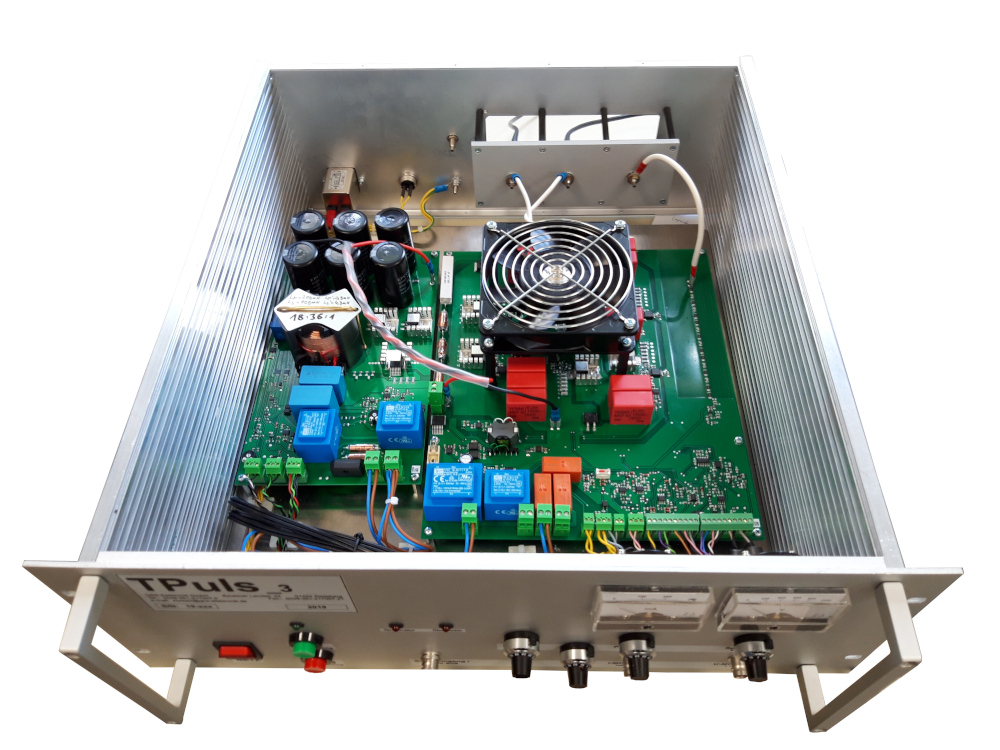High voltage pulse generator Tpuls3 for capacitive load
The pulse generator Tpuls3 is designed to deliver short but high power high voltage pulses to the primary of a ferrite ring transformer (e.g. EPCOS type). These pulses can be repeated in frequency up to 20 kHz and beyond.
The output of the transformer then delivers these pulses to a capacitive load, forming an RLC circuit. These pulses can be single-shot or resonant waves with exponential decay. We calculate, design and deliver the transformer to meet your specifications.
Typical voltages range from 1 kV to 15 kV, depending on the transformer and the nature of the load.

Applications of the high voltage pulse generator Tpuls3
Electrostatic discharge – ESD – in the semiconductor industry.
Many electronic components, such as power diodes, are very robust and can withstand an electrostatic discharge, but if a semiconductor component has a small or thin geometry within its physical structure, the voltage can locally destroy the semiconductor. The currents during these discharges become quite high, but are in the nanosecond to microsecond range. A part of the component is definitely damaged, which can cause different kinds of failures. The pulse generator Tpuls3 is used to generate this short and very energetic pulse.
Generation of high frequency electric currents in ball bearings – automotive industry
Electric vehicle drives are designed with high frequency switching circuits powered by a DC battery. These switching circuits generate very high frequency transients and harmonics that propagate into the ball bearings. These create significant damage, such as the formation of small craters in the bearing raceways, destruction of metal alloys on the surface, degradation of lubricants, etc. The consequences are : increased noise level, loss of lubricant efficiency, increased temperature, etc., all of which contribute to the reduction of the bearing’s service life. The pulse generator Tpuls3 in combination with an RLC resonant circuit allows to reproduce these high frequency waveforms assimilated to these harmonics.
Description, waveform and frequency of the pulses
The pulses are generated from an internal power supply which provides a DC bus voltage. This voltage is adjustable from 0 to 1000 V DC. Its power is 300 W for an average current of 500 mA.
The switching circuit of the pulse generator Tpuls3 is made of switching transistors in series with capacitors and diodes. This design allows the creation of a pulse at the primary terminals, the amplitude of which is double the DC bus voltage (1000 V and – 1000 V with respect to GND). When the pulse ends, the converter is stopped and the inductive energy of the reverse half-wave is returned by the diodes to the filter capacitors.
The output stage is designed to periodically deliver peak currents up to 120 A. In the event of a short circuit, the currents can be as high as 200 A. However, the pulse is switched off within 250 ns if currents > 120A are detected.
The pulse generator Tpuls3 can be triggered by an internal clock or by an external TTL signal.
The maximum value of the load capacity is determined by the peak current that the generator can deliver but also by the transformer ratio. Similarly, the energy of the output pulse depends on the duration of the initial internal pulse and the saturation of the ferrite. The internal pulse is programmable from 0 to 1.5 µs.
The rise time and fall time of the pulse are approximately the same and depend on the primary inductance of the transformer, the ratio of the transformer and the capacitive value of the load. However, if the transformer is used in a non-linear mode, so that it saturates just at the maximum voltage, the fall time can be even faster than the rise time. The frequency is limited with this mode because the losses are quite high.
The maximum frequency with internal triggering is 20 kHz. With an external trigger, the frequency can be even higher. However, due to the maximum peak power of the generator, the frequency may decrease. The limits are set by the internal parameters of the DC power supply and by the temperature monitoring circuit.
The intrinsic switching time of the transistors is about 30 ns, which is also the shortest rise time for the smallest load capacitances.
The pulse generator Tpuls3 is automatically switched off in case of high temperature due to overheating of the components.
Specifications of the Tpuls3 generator
- Power supply switch.
- Pushbuttons for HV On and Off.
- 10-turn potentiometer for frequency 0-20 kHz.
- 10-turn potentiometer for voltage.
- 10-turn potentiometer for pulse width adjustment.
- BNC input for external control signal.
- Voltage monitor output 1:2000.
- Current monitor output 50 mV/A (current transformer with shunt).
- Analog meters for primary power supply voltage and current.
- LEDs for overcurrent and overtemperature.
- 2 * 4mm plugs pulse output for transformer connections.
- 4 mm plug for voltage measurement.
- 4 mm plug ground connection.
- As the output plugs of the pulse generator Tpuls3 carry dangerous voltages they are behind a cover.
- Grid supply cable plug.
- Interlock connector.
- 19“ rack insert, 460mm deep, height 177 mm (4HE), width 482mm.
- Environmental temperature range 0-35 °C.
- Humidity 0-80%, the device is designed to operate in dry laboratory rooms.
- Protection class I, IP 20.
- Supply rating 230VAC, 2A max.
- Manual includes design guide for suitable pulse transformers.
Optional included
- Pulse generator Tpuls3 with customized internal ferrite ring transformer (Up to 10 kV peak).
- Customized external ferrite ring transformer.
- Large ferrite rings and unshielded HV cable suitable for doing pulse transformers.

